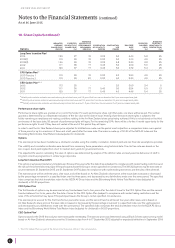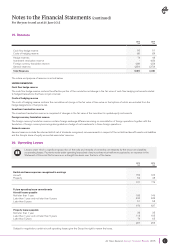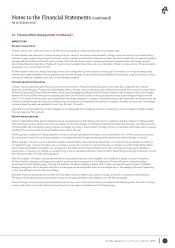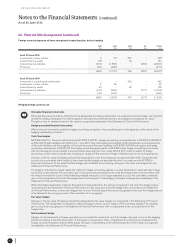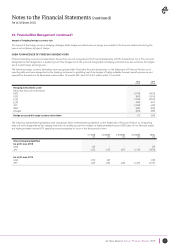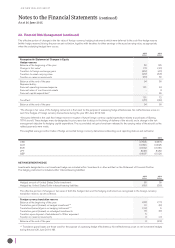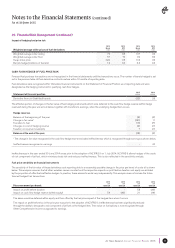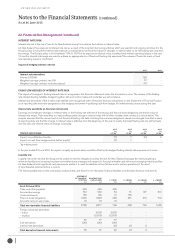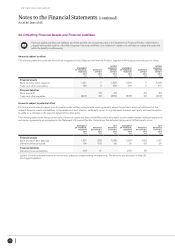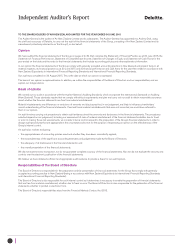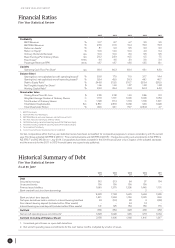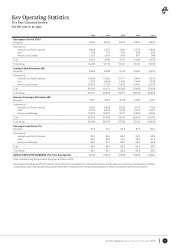Air New Zealand 2015 Annual Report Download - page 37
Download and view the complete annual report
Please find page 37 of the 2015 Air New Zealand annual report below. You can navigate through the pages in the report by either clicking on the pages listed below, or by using the keyword search tool below to find specific information within the annual report.
Notes to the Financial Statements (continued)
As at 30 June 2015
Air New Zealand Annual Financial Results 2015 35
23. Financial Risk Management (continued)
Impact of hedging fuel price risk
Weighted average strike prices of fuel derivatives
2015
Brent
USD
2015
WTI
USD
2014
Brent
USD
2014
WTI
USD
Weighted average collar ceiling
Weighted average collar floor
Swap strike price
Barrels hedged (millions of barrels)
70
57
N/A
1.9
83
76
95
0.6
107
99
104
3.6
96
86
96
0.6
CASH FLOW HEDGES OF FUEL PRICE RISK
Forecast fuel purchase transactions are not recognised in the financial statements until the transactions occur. The number of barrels hedged is set
out in the previous table. All fuel derivative contracts mature within 12 months of reporting date.
Fuel derivatives were recognised within ‘Derivative financial instruments’ on the Statement of Financial Position as at reporting date and were
designated as the hedging instrument in qualifying cash flow hedges.
Statement of financial position 2015
NZ$M
2014
NZ$M
Derivative financial (liabilities)/assets (22) 25
The effective portion of changes in the fair value of fuel hedging instruments which were deferred to the cash flow hedge reserve (within hedge
reserves) during the year are set out below, together with transfers to earnings, when the underlying hedged item occurs.
Hedge reserves
Balance at the beginning of the year
Change in fair value*
Transfers to fuel
Changes in cost of hedging reserve
Taxation on reserve movements
(2)
(151)
130
(2)
7
(4)
11
(7)
(1)
(1)
Balance at the end of the year (18) (2)
* The change in fair value recognised in the cash flow hedge reserve excludes ineffectiveness which is recognised through earnings as shown below.
Ineffectiveness recognised in earnings - 40
Ineffectiveness in the year ended 30 June 2014 arose prior to the adoption of NZ IFRS 9 on 1 July 2014. NZ IFRS 9 allows hedges of the crude
oil risk component of jet fuel, which minimises basis risk and reduces ineffectiveness. This is also reflected in the sensitivity analysis.
Fuel price sensitivity on financial instruments
The sensitivity of the fair value of these derivatives as at reporting date to a reasonably possible change in the price per barrel of crude oil is shown
below. This analysis assumes that all other variables remain constant and the respective impacts on profit before taxation and equity are dictated
by the proportion of effective/ineffective hedges. In practice, these elements would vary independently. This analysis does not include the future
forecast hedged fuel transactions.
Price movement per barrel:
2015
$M
+USD 20
2015
$M
-USD 20
2014
$M
+USD 20
2014
$M
-USD 20
Impact on profit before taxation
Impact on cash flow hedge reserve (within equity)
-
54
-
(40)
58
21
(49)
(14)
The above would be deferred within equity and then offset by the fuel price impact of the hedged item when it occurs.
The impact on profit before tax in the prior year was prior to the adoption of NZ IFRS 9. Ineffectiveness has been significantly reduced
through the ability to designate a risk component of jet fuel as the hedged item. Time value on fuel options is now recognised through
Other Comprehensive Income as opposed to earnings.



